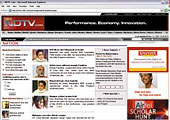|
In
the US, they are already writing the requiem for print publications.
The Sulzbergers, who control The New York Times, are fighting
a battle with institutional investors, apparently for a change
in its dual ownership structure, but in reality over the newspaper's
poor financial performance. Elsewhere in the city, the Bancrofts,
who own Dow Jones, including the jewel in the crown, The Wall
Street Journal, have been offered a $5-billion deal by media mogul
Rupert Murdoch. And in early April, real estate baron Sam Zell
snapped up the Tribune Co. (which publishes the la Times and the
Chicago Tribune) for $8.2 billion. The Grahams, who control The
Washington Post, made the first layoffs in 25 years after profits
fell in the third quarter of last year. The world, according to
American advertisers, is online.
Cut to India, the situation couldn't be more
different. Print is booming. All the big media houses-Bennett,
Coleman & Co, ht Media, and Living Media India (read: the
India Today Group)-have either launched or will launch new print
properties, including newspapers and magazines. Then, there are
smaller, regional players such as Gujarat Samachar and Malayala
Manorama that are expanding their portfolios. Yet, the underlying
turbulence is all too visible-in readership numbers. Although
the methodology is a subject of debate, the India Readership Survey
for the second half of calendar 2006 points to a drop in readership
of all major print publications, including national dailies and
magazines. Advertisers, on the other hand, are pressing for more
bang for their advertising buck, not just in print, but also television.
 |
 |
"We want to be
the leader in the consumer internet space in the
next couple of years"
Surya Mantha
CEO, Web18 |
"The market is shifting
to the digital domain, and growth rates here are the fastest"
Dinesh Wadhawan
MD & CEO, Times Internet |
Result: Old media, whose early dalliance with
the internet was limited to putting its content online, is beginning
to look at the opportunity as an independent business that goes
beyond news. Consider Bennett, Coleman & Co, for example.
This media giant, which publishes The Times of India and The Economic
Times, has a separate digital venture, called Times Internet,
which owns portals such as timesjobs.com (jobs classifieds), magicbricks.com
(real estate), and simplymarry.com. It even has private equity
investment of $7 million from Sequoia Capital India.
Another aggressive old media player is tv18,
whose internet arm Web18 has been on a spree to acquire toeholds
in various dotcoms such as Yatra.com (where it is a co-investor
with Norwest Venture Partners and Reliance Capital), Jobstreet.com
India, Cricketnext.com, Compareindia.com, Urban Eye, and Big Tree
Entertainment. NDTV, too, has spun off its internet division into
a separate entity, NDTV Convergence, and brought in a new CEO
from Indiatimes, Sanjay Trehan. Other media houses, including
the India Today Group, which publishes Business Today, have ambitious
internet plans. Says NDTV Convergence's Trehan: "Gone are
the hype days of the net. This is a very serious business now."
Not Just a New Medium
Having seen Internet 1.0 flame out in India
some years ago, all the media companies are much clearer about
their web strategy. Web18, which closed 2006-07 with Rs 25 crore
in revenues, wants to be "the leader in the consumer internet
space in the next couple of years," says Surya Mantha, CEO
of the division. Dinesh Wadhawan, MD & CEO, Times Internet,
says he is going to get "very aggressive" in the coming
few months on community-based services, improved functionality
and navigation, and on content. "We are going to go beyond
Orkut (a popular social networking site) and create relevant communities
for different walks of life, be it working women, elderly or even
kids." The company is also planning products in vernacular
languages (it's talking to other publishers to aggregate news)
as well as local search and even going hyper-local. "We will
blend assets from Web 2.0 as well as the existing version. Online
companies need to evolve unless we want to create a cyber Jurassic
Park," he warns. Adds Alok Mittal, Executive Director, Canaan
Partners: "It is very important for old media to look at
internet as a standalone business, and not just as an extension
of their print business."
|
WHAT OLD MEDIA COMPANIES ARE DOING
|
|
Media House/ Growth
Plans
Web18
To be the leader in the consumer internet space in
the coming few years
Times Internet
It sees fresh activity in communities, apart from
the verticals it is present in
IMCL (Bhaskar
Group)
Optimistic about e-commerce and local search
ABP Group
Intends to gain from content customisation, local
information and search specific portals for markets in the
East
Express Online
Plans to increase net revenues to around 20 per cent
of total in the next few years
Gujarat Samachar
Along with a business portal launch in 2008, it expects
to increase focus on classifieds
Malayala Manorama
Plans to increase verticals around local communities
NDTV Convergence
Sees growth coming from the search engine market,
monitored-community portals and innovative advertising techniques
|
Regional players have their own plans, but
built largely around the communities they already cater to. Manorama
Online's CEO, Mariam Mammen Mathew, says the group's 22 bilingual
(Malayalam and English) web channels will be weaved into one Web
2.0 site, encouraging users to build communities around user-generated
content. Kolkata-based ABP Group, which publishes The Telegraph
and Ananda Bazar Patrika, already has community portals like anandautsav.com,
tilottama.in and ilovekolkata.in that attract a lot of hits from
overseas (presumably, from non-resident Bengalis), but intends
to go deeper into the eastern market by offering content in more
local languages (Assamese, Oriya, etc). "The next wave,"
says Asheesh K. Gupta, VP (Business Development & Strategy),
ABP Group, "is going to be about customisation of content
in terms of geography and language, and there is going to be a
shift from universal search to local search."
 |
"Gone
are the hype days of the net. This is a very serious business
now"
Sanjay Trehan
CEO/NDTV Convergence |
The (Dainik) Bhaskar Group and Gujarat Samachar
are some other regional media houses that intend to stick to the
knitting. "We are market leaders in the Gujarati community,
be it India or abroad, and venturing into other languages does
not make sense unless we have some expertise in the market,"
says Shreyan Shah, CMD, Gujarat Samachar. He is launching a business
portal in 2008, and is looking at ways to increase the local classified
section online to attract more users and advertisers. Currently,
most of its traffic is driven by the Gujarati diaspora. Bhaskar
Group's R.D. Bhatnagar, on the other hand, says that e-commerce
is what will drive their net strategy. "By 2010, we expect
the online business to contribute Rs 500 crore in revenues,"
he says.
Evidently, the idea is to get more users
online and then start monetising the growth. NDTV Convergence's
Trehan says that his plan is to go as "granular" (read:
local) as possible, since there is a lot of potential to do local
search-engine based marketing and video advertising online. The
company, which in tranches has raised $4.5 million, expects to
clock revenues of Rs 100 crore by 2010. Web18's Mantha believes
that there's room for subscription-based portals as well "as
long as they have unique and compelling content and solutions".
Here's the real opportunity, though: All
the media players see online advertisement rates going up in the
future. "This is still an under-valued medium where advertisers
are sceptical either because they were misled in the early days
by gold-diggers or because the industry itself didn't do much
to build confidence," says Times Internet's Wadhawan. But
for that, the media owners will have to innovate and lean on more
sophisticated advertising tools and techniques. "We know
that the market is shifting to the digital domain, and growth
rates here are the fastest," says Wadhawan. In the US, that
turned into an adversity for the print monoliths. But in India,
that may well be an opportunity.
|










